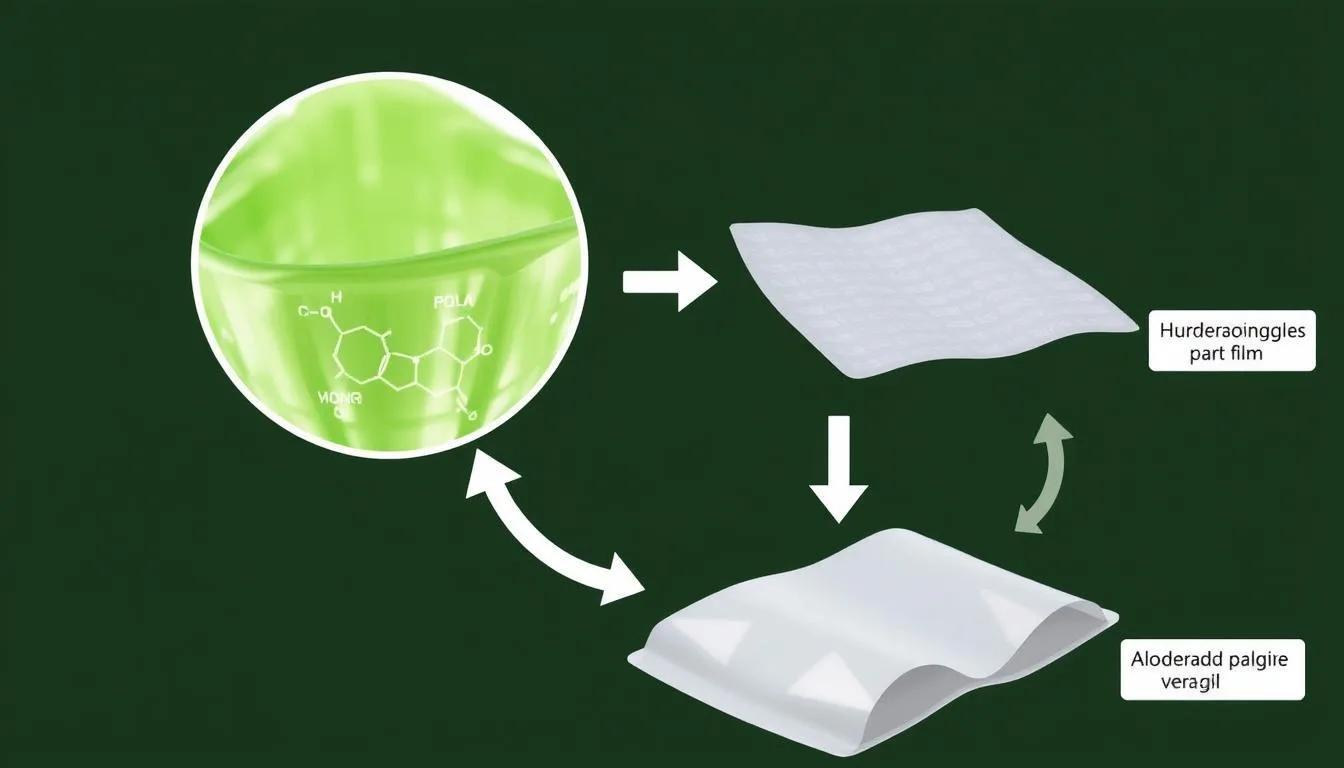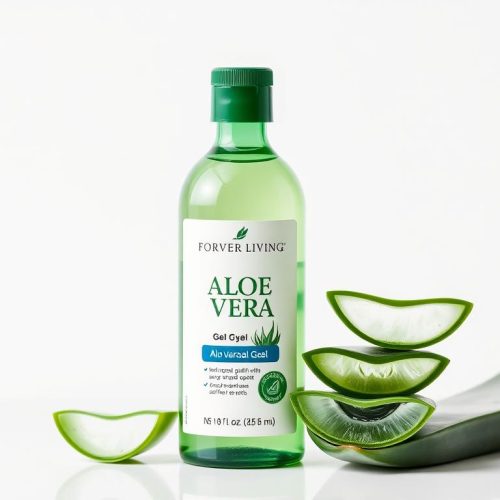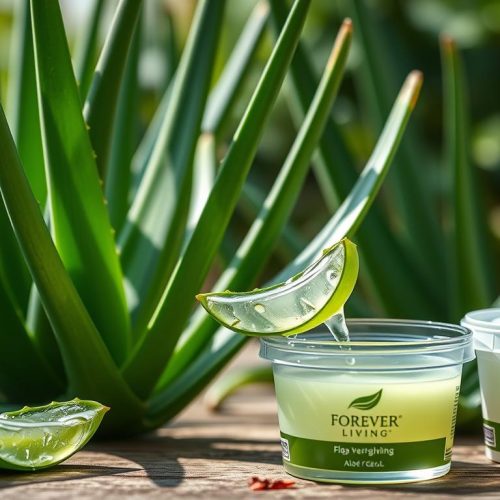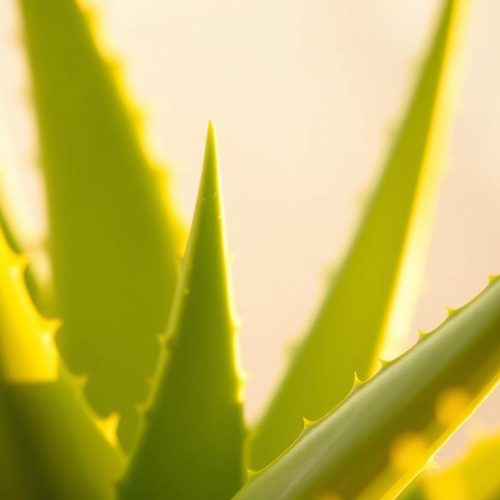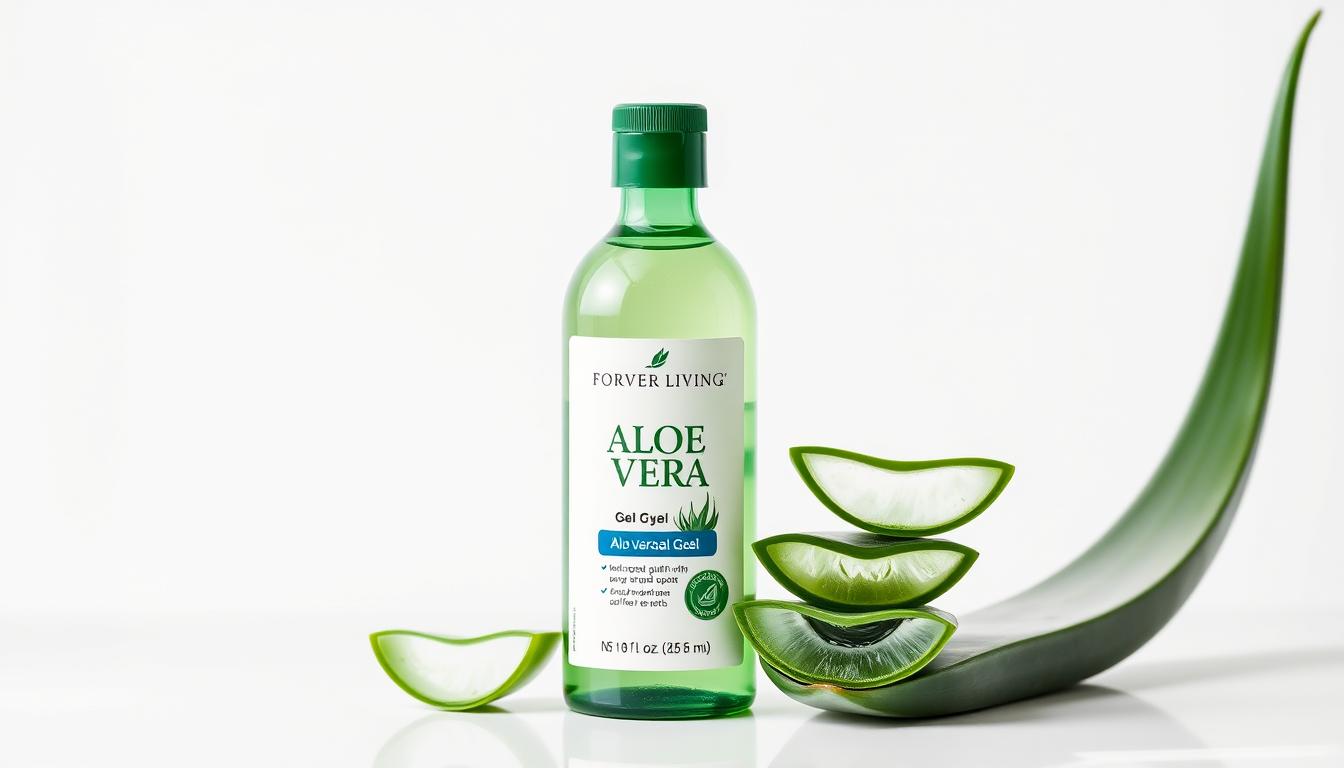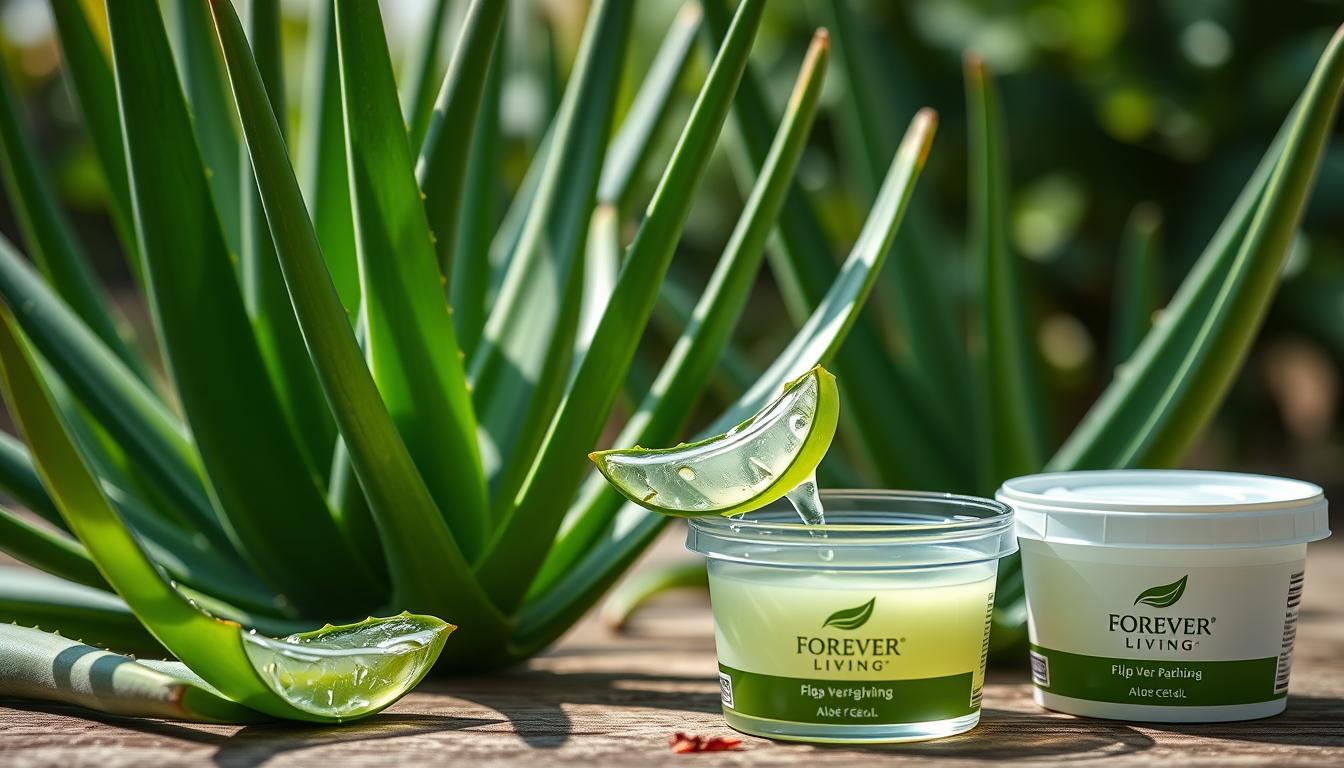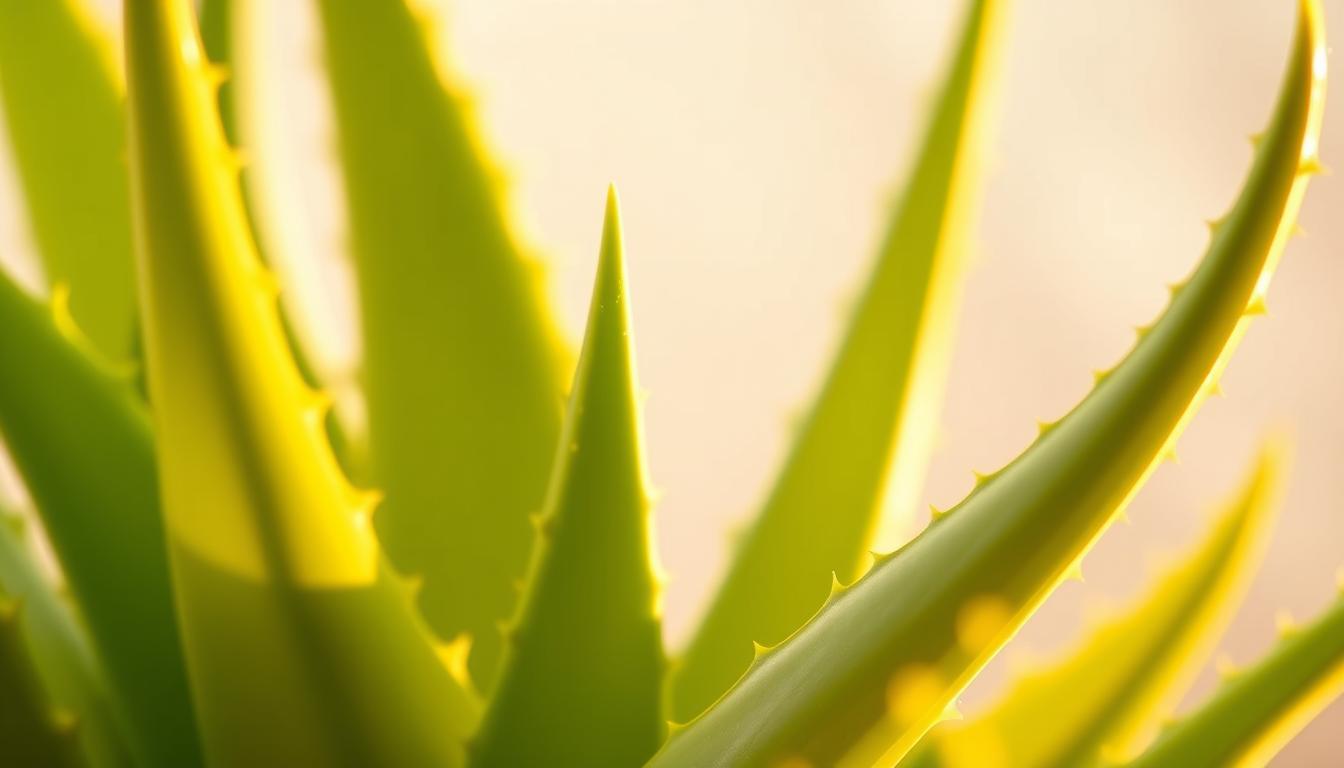In a world drowning in plastic waste, innovative solutions are emerging from unexpected sources. Aloe Vera biodegradable packaging represents a groundbreaking shift in how we think about product containment and environmental responsibility. This remarkable plant, long celebrated for its medicinal properties, is now at the forefront of sustainable packaging revolution. As global brands face mounting pressure to reduce their environmental footprint, Aloe Vera-based materials offer a promising alternative that combines functionality with genuine eco-credentials.
The global packaging industry produces over 400 million tons of plastic annually, with less than 9% being recycled. This staggering reality has accelerated the search for truly biodegradable alternatives that don’t compromise on performance. Aloe Vera biodegradable packaging is emerging as a leading solution, offering comparable protection while decomposing naturally in weeks rather than centuries.
- Understanding Aloe Vera Biodegradable Packaging: The Science Behind the Innovation
- Environmental and Commercial Benefits of Aloe Vera Biodegradable Packaging
- Pioneering Brands Embracing Aloe Vera Biodegradable Packaging
- Implementation Challenges and Solutions
- Future Outlook: The Evolving Landscape of Aloe Vera Biodegradable Packaging
- Implementation Guide: Integrating Aloe Vera Biodegradable Packaging into Your Brand
- Conclusion: Embracing the Future of Sustainable Packaging
- Understanding Aloe Vera Biodegradable Packaging: The Science Behind the Innovation
- Environmental and Commercial Benefits of Aloe Vera Biodegradable Packaging
- Pioneering Brands Embracing Aloe Vera Biodegradable Packaging
- Implementation Challenges and Solutions
- Future Outlook: The Evolving Landscape of Aloe Vera Biodegradable Packaging
- Implementation Guide: Integrating Aloe Vera Biodegradable Packaging into Your Brand
- Conclusion: Embracing the Future of Sustainable Packaging
Understanding Aloe Vera Biodegradable Packaging: The Science Behind the Innovation
The transformation process of Aloe vera gel into biodegradable packaging material
Aloe Vera biodegradable packaging harnesses the unique properties of the plant’s gel to create films and containers that offer an environmentally responsible alternative to conventional plastics. The journey from plant to packaging involves several sophisticated yet sustainable processes that preserve the beneficial properties of Aloe Vera while creating durable, functional materials.
From Plant to Polymer: The Extraction Process
The creation of Aloe Vera biodegradable packaging begins with the careful extraction of gel from mature Aloe Vera leaves. This gel, composed primarily of polysaccharides, organic acids, and various bioactive compounds, forms the foundation of the biodegradable material. Unlike synthetic polymers derived from petroleum, Aloe Vera gel is completely natural and renewable, requiring minimal processing to maintain its beneficial properties.
Scientists have discovered that when Aloe Vera gel is combined with other natural polymers such as starch, the resulting composite exhibits remarkable physical properties. Research published in the Current World Environment journal demonstrates that Aloe Vera gel functions effectively as a plasticizer, enhancing the flexibility and processability of bioplastic materials while maintaining adequate mechanical strength.
The Chemical Composition and Biodegradable Properties
What makes Aloe Vera biodegradable packaging particularly valuable is its unique chemical structure. The gel contains:
- Long-chain polysaccharides that provide structural integrity
- Natural glycoproteins that enhance film flexibility
- Organic acids that act as natural preservatives
- Phenolic compounds that create crosslinking between polymer chains
- Water-soluble vitamins and minerals that accelerate biodegradation
When processed into packaging material, these components work synergistically to create a material that offers protection similar to conventional plastics but breaks down naturally when exposed to environmental conditions. Aloe Vera packaging typically degrades completely within 12-16 weeks, compared to 450+ years for conventional plastics, representing a dramatic improvement in environmental impact.
Production Methods and Technological Innovations
Several methods have been developed to transform Aloe Vera gel into viable packaging materials:
Film Casting Method
Aloe Vera gel is combined with starch or other biopolymers, then cast into thin sheets and dried under controlled conditions. This method produces flexible films suitable for wrapping and pouches.
Thermoplastic Processing
Aloe Vera gel is used as a plasticizer with thermoplastic starch, processed through heat and pressure to create more rigid packaging forms like trays and containers.
Composite Formulation
Aloe Vera gel is incorporated into composite materials with other natural fibers or biodegradable polymers to enhance specific properties like water resistance or tensile strength.
Recent technological advancements have significantly improved the performance of Aloe Vera biodegradable packaging. Researchers at multiple institutions have demonstrated that by optimizing the ratio of Aloe Vera gel to other biopolymers, it’s possible to create materials with tensile strength comparable to conventional plastics while maintaining excellent biodegradability.
Want to Understand the Technical Details?
Download our comprehensive technical guide on Aloe Vera biodegradable packaging formulations, production methods, and performance specifications.
Environmental and Commercial Benefits of Aloe Vera Biodegradable Packaging
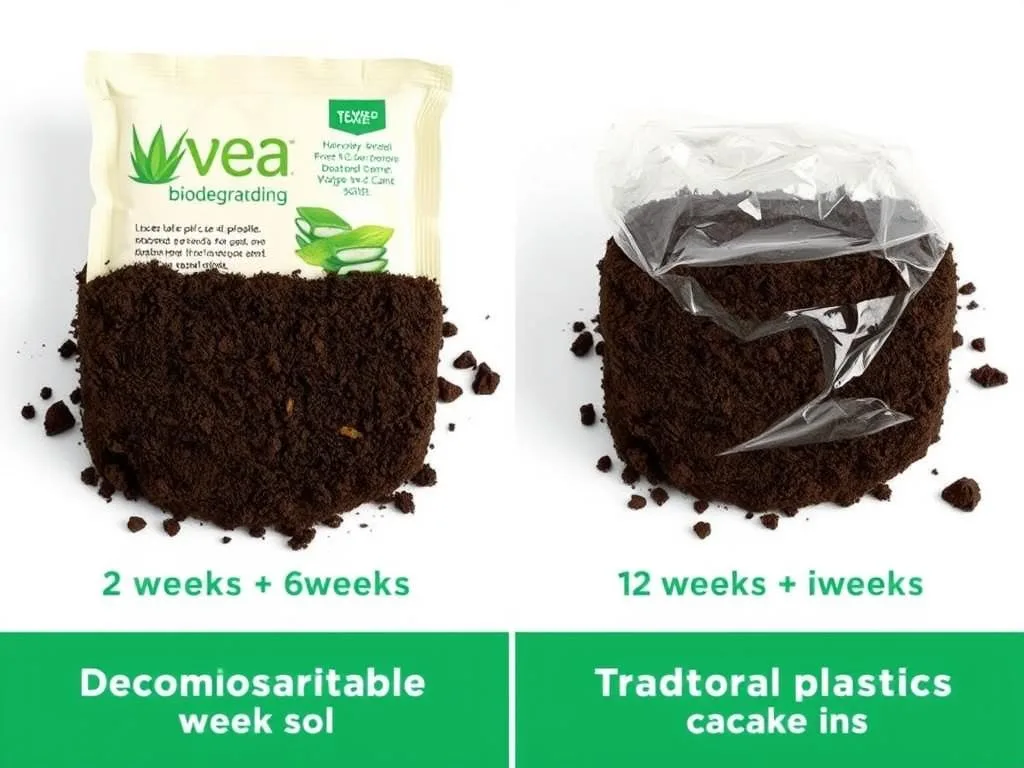
Biodegradation timeline: Aloe Vera packaging vs. conventional plastic
The shift toward Aloe Vera biodegradable packaging represents more than just an environmental choice—it offers tangible benefits for businesses and consumers alike. As brands increasingly recognize the value of sustainable practices, Aloe Vera-based materials provide a compelling alternative that addresses multiple concerns simultaneously.
Environmental Impact: Beyond Biodegradability
The environmental advantages of Aloe Vera biodegradable packaging extend far beyond its ability to decompose naturally. When compared to conventional plastics and even other bioplastics, Aloe Vera-based materials demonstrate superior environmental performance across multiple metrics:
Reduced carbon footprint: Production of Aloe Vera biodegradable packaging generates up to 60% less greenhouse gas emissions than conventional plastic production
Lower water consumption: Requires approximately 45% less water throughout its lifecycle compared to petroleum-based plastics
Renewable resource utilization: Made from plants that can be continuously regrown, unlike finite fossil resources
Non-toxic decomposition: Breaks down into natural compounds that nourish rather than contaminate soil
Reduced marine impact: If accidentally released into aquatic environments, degrades without releasing harmful microplastics
Biodegradation Timeline
Aloe Vera biodegradable packaging: 12-16 weeks
PLA bioplastic: 24-36 months
Paper packaging: 2-5 months
Conventional plastic: 450+ years
Performance Characteristics: Meeting Commercial Requirements
For any sustainable packaging solution to gain widespread adoption, it must perform effectively in real-world applications. Aloe Vera biodegradable packaging has demonstrated impressive functional properties that make it suitable for various commercial uses:
| Property | Aloe Vera Packaging | Conventional Plastic | Other Bioplastics |
| Tensile Strength | 5.5-9.1 MPa | 10-60 MPa | 3.7-5.0 MPa |
| Water Vapor Permeability | Low-Medium | Very Low | Medium-High |
| Oxygen Barrier | Good | Excellent | Fair |
| UV Resistance | Medium-High | Low (without additives) | Low |
| Heat Resistance | Up to 100°C | Up to 120-140°C | Up to 60-80°C |
Research published in Polymer Bulletin demonstrates that Aloe Vera gel significantly improves the mechanical properties of bioplastic films. When used as a crosslinker, Aloe Vera gel can increase tensile strength by up to 791% compared to films without Aloe Vera. This remarkable improvement makes Aloe Vera biodegradable packaging suitable for applications that previously required conventional plastics.
Economic Considerations: The Business Case
While environmental benefits are compelling, businesses must also consider economic factors when evaluating packaging alternatives. Aloe Vera biodegradable packaging offers several advantages that contribute to a strong business case:
Consumer preference: 73% of consumers are willing to pay more for products with sustainable packaging
Regulatory compliance: Meets increasingly stringent regulations on single-use plastics in many regions
Brand differentiation: Provides tangible evidence of environmental commitment
Supply chain resilience: Reduces dependency on petroleum-based materials subject to price volatility
Waste management savings: Lower disposal costs and potential for composting rather than landfilling
While current production costs for Aloe Vera biodegradable packaging remain somewhat higher than conventional plastics, this gap is narrowing as production scales and technologies improve. Many brands find that the premium is offset by marketing advantages, consumer loyalty, and alignment with corporate sustainability goals.
Pioneering Brands Embracing Aloe Vera Biodegradable Packaging

Various consumer products utilizing Aloe Vera biodegradable packaging solutions
Forward-thinking companies across multiple industries are already incorporating Aloe Vera biodegradable packaging into their product lines. These early adopters are demonstrating both the feasibility and the competitive advantages of embracing this innovative solution. Their experiences provide valuable insights for other brands considering similar transitions.
Cosmetics Industry: Natural Beauty, Natural Packaging
The cosmetics industry has been particularly receptive to Aloe Vera biodegradable packaging, recognizing the natural alignment between clean beauty formulations and sustainable packaging solutions. Several pioneering brands have successfully implemented Aloe Vera-based materials:
EcoLuxe Skincare
This premium skincare brand transitioned its entire line of facial serums to Aloe Vera biodegradable packaging in 2022. The company reports that the switch not only reduced their packaging carbon footprint by 57% but also resonated strongly with their target demographic of environmentally conscious consumers.
“Our customers were already drawn to our natural formulations,” explains EcoLuxe founder Maria Chen. “When we introduced Aloe Vera biodegradable packaging, we saw a 32% increase in repeat purchases and significant positive feedback on social media platforms.”
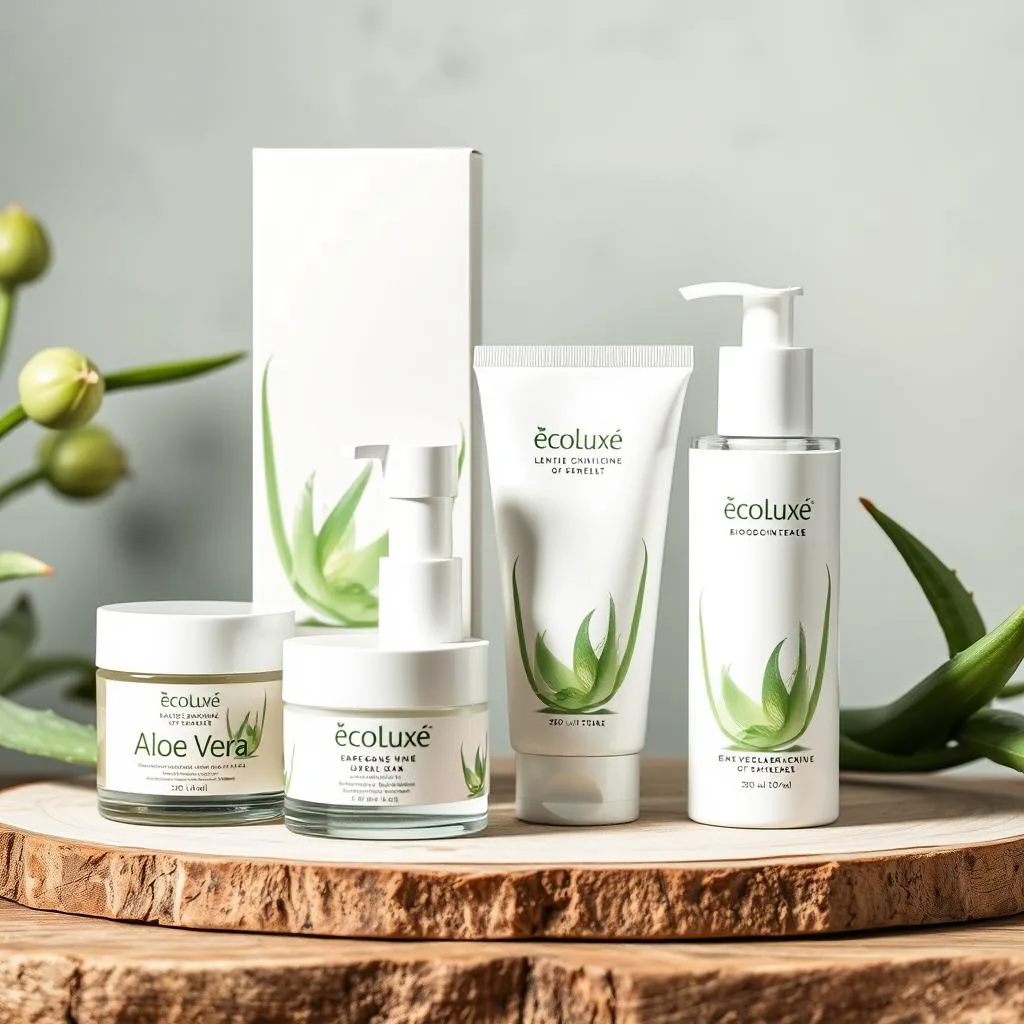
PureElements Cosmetics
This color cosmetics brand developed a line of lipsticks and compact powders housed entirely in Aloe Vera biodegradable packaging. The company worked closely with material scientists to ensure the packaging maintained product integrity while meeting their sustainability goals.
PureElements reported that the initiative not only attracted new environmentally conscious customers but also generated significant media coverage, resulting in a 45% increase in brand awareness metrics within six months of launch.
Food Industry: Preserving Freshness Sustainably
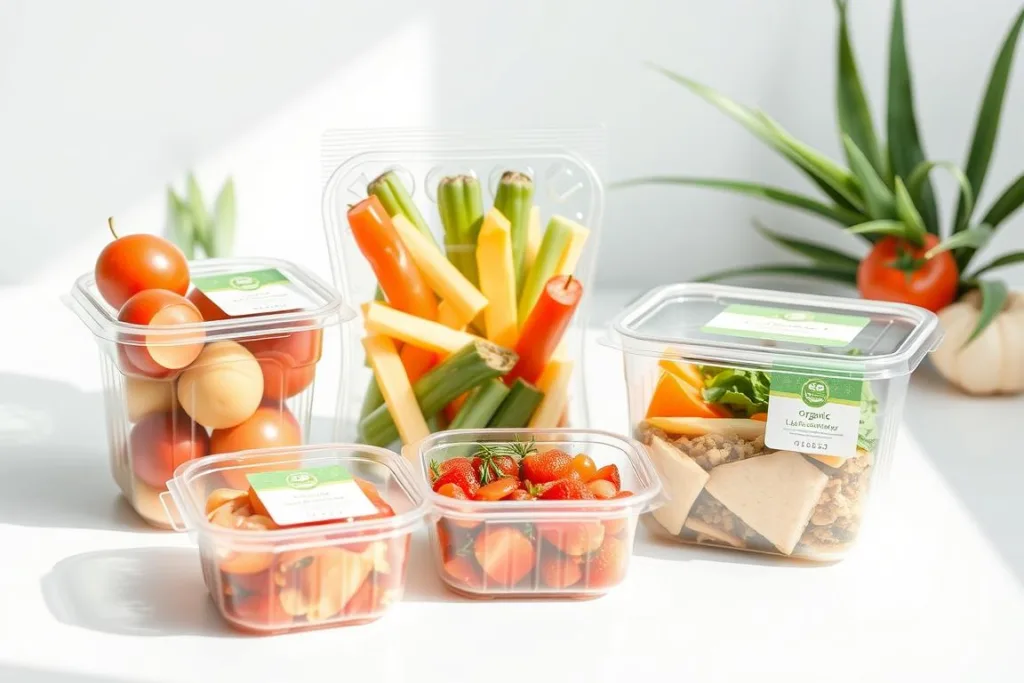
Organic produce and prepared foods in Aloe Vera biodegradable containers
The food industry faces unique challenges in packaging, requiring solutions that maintain freshness while addressing growing consumer concerns about plastic waste. Aloe Vera biodegradable packaging has proven effective in several food applications:
GreenHarvest Organics
This organic produce company replaced conventional plastic clamshells with Aloe Vera biodegradable containers for their premium berry line. Internal testing confirmed that the Aloe Vera packaging maintained fruit freshness comparably to conventional options while offering superior end-of-life environmental benefits.
“We were initially concerned about moisture management,” notes GreenHarvest operations director James Wilson. “But the Aloe Vera packaging actually helped maintain optimal humidity levels for our berries, extending shelf life by approximately 12% compared to our previous packaging.”
PureNourish Meal Delivery
This meal delivery service transitioned from plastic containers to Aloe Vera biodegradable trays and films for their prepared meals. The company reports that customer satisfaction increased by 28% following the change, with many subscribers citing the sustainable packaging as a key factor in their continued loyalty.
Personal Care: Aligning Product and Packaging
Personal care brands have found particular success with Aloe Vera biodegradable packaging, especially those already utilizing Aloe Vera in their formulations:
NatureSoothe
This natural personal care brand created a “packaging that matches the product” initiative, housing their Aloe Vera-infused body lotions and gels in Aloe Vera biodegradable tubes and bottles. The conceptual alignment resonated strongly with consumers, driving a 41% increase in new customer acquisition.
The company’s marketing director explains: “We’ve created a complete circle of sustainability—Aloe Vera in the product, Aloe Vera in the packaging, and both returning to the earth naturally after use. Consumers immediately understand and appreciate this holistic approach.”
Ready to Explore Aloe Vera Packaging for Your Brand?
Request our case study collection featuring detailed implementation stories, challenges overcome, and measurable results from brands that have successfully adopted Aloe Vera biodegradable packaging.
Implementation Challenges and Solutions

Commercial-scale production facility for Aloe Vera biodegradable packaging materials
While Aloe Vera biodegradable packaging offers compelling benefits, its implementation is not without challenges. Understanding these obstacles—and the emerging solutions—is essential for brands considering adoption of this innovative material.
Scaling Production: From Laboratory to Commercial Reality
One of the primary challenges facing Aloe Vera biodegradable packaging is scaling production to meet commercial demand. Currently, most production occurs at relatively small scales, which impacts both cost and availability.
- Several specialized manufacturers have developed semi-automated processes for Aloe Vera film production
- Agricultural innovations have increased Aloe Vera crop yields by up to 35% in the past five years
- Strategic partnerships between material scientists and manufacturing experts are accelerating commercialization
- Investment in production facilities has increased by 78% since 2020
Progress in Scaling
- Production capacity remains limited compared to conventional plastics
- Specialized equipment requirements increase initial capital costs
- Standardization across different manufacturers is still developing
- Supply chain infrastructure for raw materials needs further development
Remaining Challenges
Industry experts predict that production capacity will increase significantly over the next 3-5 years as more manufacturers enter the market and existing players expand their operations. This expansion is expected to drive down costs while increasing availability for brands of all sizes.
Cost Considerations: Economic Viability
Current cost differentials between Aloe Vera biodegradable packaging and conventional alternatives represent another implementation challenge. However, this gap is narrowing as several factors converge:
Economies of scale: As production volumes increase, per-unit costs are decreasing by approximately 15-20% annually
Process optimization: Manufacturers are developing more efficient extraction and processing methods
Rising costs of alternatives: Plastic packaging costs are increasing due to regulatory pressures and consumer demand for sustainability
Value chain integration: Vertical integration is reducing costs by eliminating intermediaries
Premium positioning: Many brands successfully position the additional cost as a value-added feature that justifies premium pricing
A comprehensive cost analysis should consider not only direct material costs but also potential marketing benefits, regulatory compliance advantages, and alignment with long-term sustainability goals. When viewed holistically, many brands find that Aloe Vera biodegradable packaging offers compelling value despite current price premiums.
Technical Limitations and Ongoing Innovations
While Aloe Vera biodegradable packaging has made tremendous strides, certain technical limitations remain. Researchers and manufacturers are actively addressing these challenges through ongoing innovation:
| Challenge | Current Limitation | Emerging Solutions |
| Moisture Sensitivity | Higher water vapor transmission than conventional plastics | Hybrid formulations with natural waxes; structural modifications to polymer chains |
| Thermal Stability | Lower heat resistance limits some applications | Cross-linking enhancements; addition of heat-stable natural fibers |
| Consistency | Variation in natural raw materials affects standardization | Advanced quality control processes; standardized extraction methods |
| Shelf Life | May begin biodegrading prematurely in high-humidity environments | Protective coatings; triggered degradation mechanisms |
These technical challenges are being addressed through collaborative research between academic institutions and industry partners. Recent breakthroughs in polymer science and material engineering suggest that many current limitations will be overcome in the near future, further expanding the potential applications for Aloe Vera biodegradable packaging.
Regulatory Landscape and Certification
Navigating the complex regulatory environment for packaging materials presents another challenge for brands considering Aloe Vera biodegradable packaging. Different regions have varying standards for biodegradability claims and material safety:
Food contact approval: Most Aloe Vera biodegradable packaging formulations have received FDA and EU approval for food contact applications
Biodegradability certification: Leading formulations have achieved certification under ASTM D6400, EN 13432, and other international standards
Compostability verification: Many variants are certified for both industrial and home composting environments
Labeling requirements: Vary by jurisdiction but generally require specific language regarding disposal methods
Working with experienced manufacturers who understand these regulatory requirements can significantly simplify the implementation process. Many suppliers now offer pre-certified formulations that meet relevant standards across multiple markets, reducing the compliance burden for brands.
Future Outlook: The Evolving Landscape of Aloe Vera Biodegradable Packaging
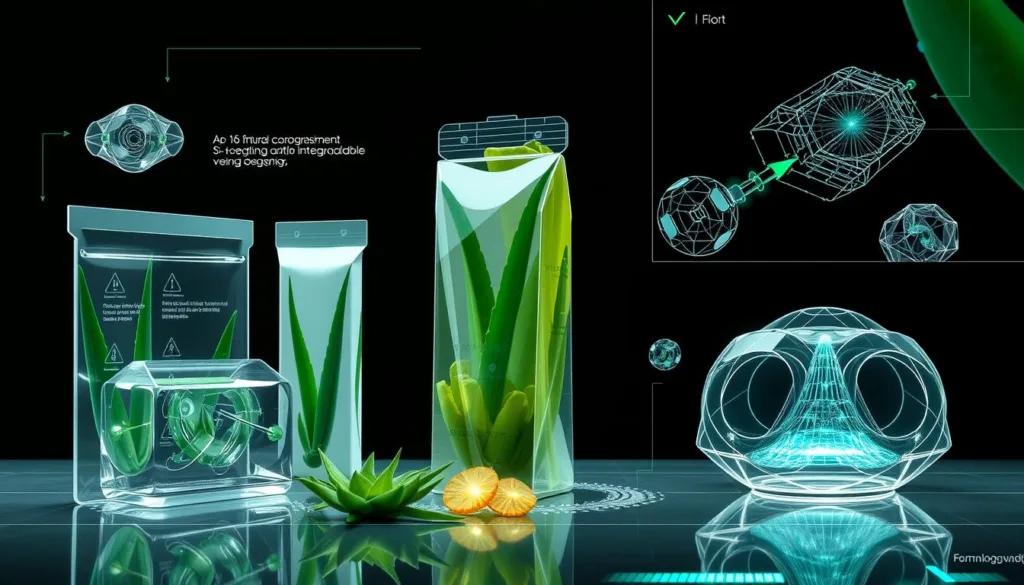
Conceptual visualization of next-generation Aloe Vera biodegradable packaging applications
The field of Aloe Vera biodegradable packaging is rapidly evolving, with emerging trends and innovations poised to expand its applications and impact. Understanding these developments provides valuable insight into the future trajectory of sustainable packaging solutions.
Emerging Research and Development Trends
Scientific research into Aloe Vera biodegradable packaging continues to accelerate, with several promising directions:
Smart packaging integration: Researchers are developing Aloe Vera films with embedded natural indicators that change color when food begins to spoil
Antimicrobial properties:The natural antibacterial compounds in Aloe Vera are being enhanced to create packaging that actively extends product shelf life
Barrier optimization: New formulations are dramatically improving oxygen and moisture barrier properties to expand potential applications
Multi-layer solutions: Composite structures combining Aloe Vera with other biodegradable materials are achieving performance comparable to conventional multi-layer plastics
3D-printable formulations: Researchers have developed Aloe Vera-based materials compatible with additive manufacturing for custom packaging solutions
These research directions suggest that the performance gap between Aloe Vera biodegradable packaging and conventional plastics will continue to narrow, potentially eliminating performance trade-offs entirely for many applications.
Market Projections and Industry Adoption
Market analysts project significant growth for Aloe Vera biodegradable packaging over the coming decade:
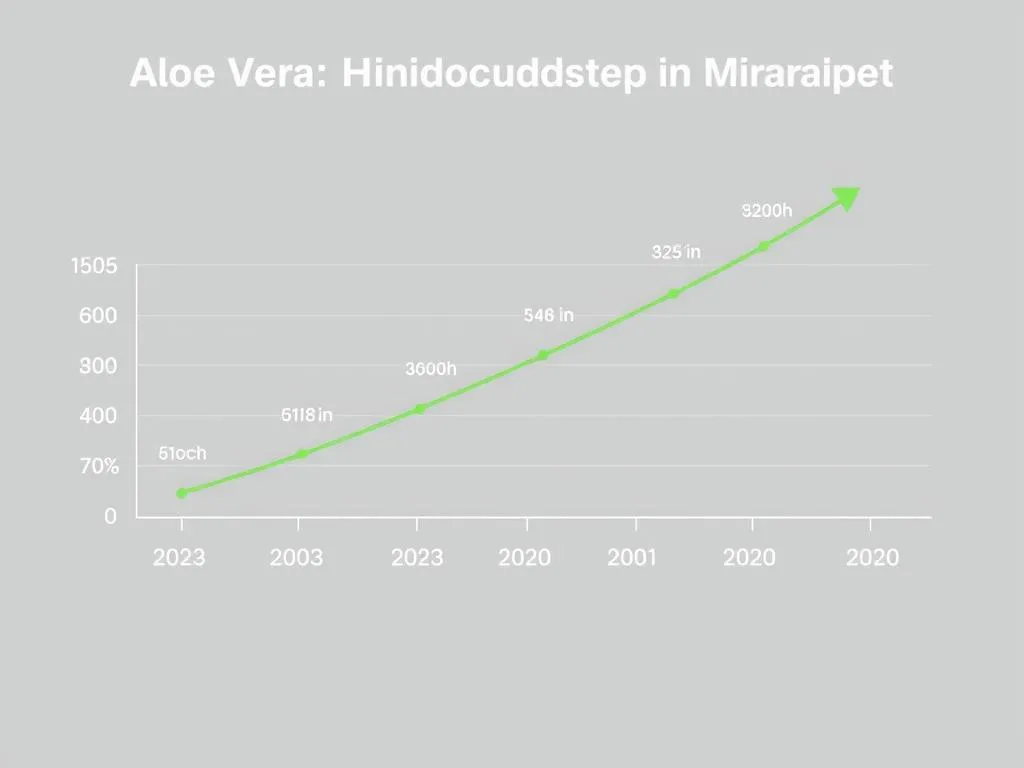
Projected market growth for Aloe Vera biodegradable packaging, 2023-2030
The global market for Aloe Vera biodegradable packaging is expected to grow at a compound annual growth rate (CAGR) of approximately 23.5% between 2023 and 2030, reaching an estimated value of $1.8 billion by the end of the forecast period. This growth is driven by several factors:
Increasing regulatory pressure: More than 127 countries have now implemented or proposed restrictions on single-use plastics
Growing consumer demand: 82% of consumers report they consider environmental impact when making purchasing decisions
Corporate sustainability commitments: Over 300 major global brands have pledged to transition to sustainable packaging by 2030
Technological advancements: Continuing improvements in performance and cost-effectiveness
Investment influx: Venture capital funding for sustainable packaging innovations has increased by 156% since 2020
Industry adoption is expected to follow a cascading pattern, with premium brands in cosmetics and natural products leading the way, followed by mainstream consumer packaged goods as costs decrease and performance improves.
Integration with Circular Economy Principles
The future of Aloe Vera biodegradable packaging is increasingly aligned with broader circular economy principles, moving beyond simple biodegradability to more comprehensive sustainability:

Circular economy model for Aloe Vera biodegradable packaging systems
Advanced implementations of Aloe Vera biodegradable packaging are incorporating:
Regenerative agriculture: Sourcing Aloe Vera from farming systems that rebuild soil health and sequester carbon
Zero-waste processing: Utilizing all parts of the Aloe Vera plant, with leaf remnants becoming agricultural inputs
Closed-loop water systems: Recapturing and purifying water used in processing
Renewable energy manufacturing: Powering production facilities with solar and other renewable sources
Compost-to-farm connections: Creating systems where post-consumer packaging becomes agricultural input
These integrated approaches maximize the environmental benefits of Aloe Vera biodegradable packaging while creating resilient, sustainable supply chains that benefit all stakeholders.
Stay at the Forefront of Sustainable Packaging Innovation
Join our network of sustainability professionals to receive quarterly updates on the latest developments in Aloe Vera biodegradable packaging and other eco-friendly innovations.
Implementation Guide: Integrating Aloe Vera Biodegradable Packaging into Your Brand
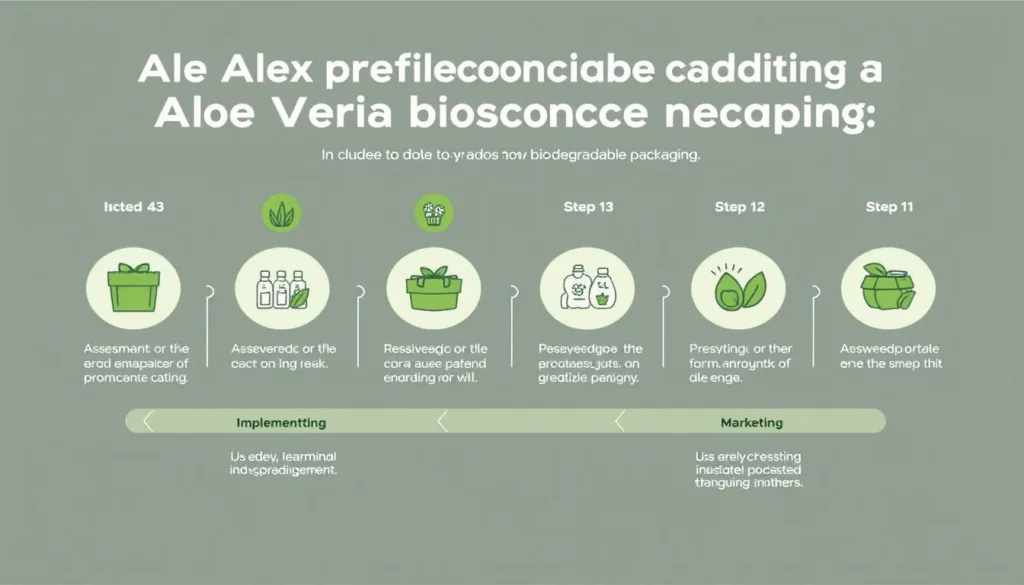
Step-by-step implementation roadmap for brands transitioning to Aloe Vera biodegradable packaging
For brands considering the transition to Aloe Vera biodegradable packaging, a structured approach can help navigate the complexities and maximize the benefits of implementation. This guide outlines key steps and considerations for successful integration.
Assessment and Planning
The implementation journey begins with thorough assessment and strategic planning:
Packaging audit: Evaluate current packaging portfolio to identify suitable candidates for transition
Performance requirements: Document specific technical requirements for each packaging application
Sustainability goals: Clarify how Aloe Vera biodegradable packaging aligns with broader sustainability objectives
Timeline development: Create realistic implementation schedule with phased approach if necessary
Budget allocation: Determine investment parameters and ROI expectations
Many brands find it beneficial to begin with limited-edition products or specific product lines before expanding to their full portfolio. This approach allows for testing and refinement while building consumer awareness and acceptance.
Supplier Selection and Material Testing
Choosing the right partners and thoroughly testing materials are critical steps in the implementation process:
Key Supplier Evaluation Criteria
- Production capacity and scalability
- Quality control processes and consistency
- Relevant certifications (food safety, biodegradability, etc.)
- Transparency in sourcing and manufacturing
- Technical support capabilities
- Track record with similar implementations
- Alignment with brand values and sustainability goals
Essential Testing Parameters
- Barrier properties (oxygen, moisture, light)
- Mechanical strength under various conditions
- Compatibility with filling/packaging equipment
- Stability during transportation and storage
- Shelf life impact on contained products
- Print/label adhesion and appearance
- Biodegradation in intended disposal environments
Working with experienced testing laboratories can provide objective verification of material performance. Many suppliers also offer pilot testing programs that allow brands to evaluate materials in real-world conditions before full-scale implementation.
Supply Chain Integration and Production Adaptation
Successfully integrating Aloe Vera biodegradable packaging often requires adjustments to existing supply chain and production processes:
- Equipment assessment: Evaluate compatibility with existing filling and packaging equipment
- Staff training: Ensure production teams understand handling requirements and quality parameters
- Storage considerations: Implement appropriate storage conditions for raw materials
- Quality control protocols: Develop specific QC procedures for the new materials
- Contingency planning: Create backup plans for potential supply disruptions
Many brands find that Aloe Vera biodegradable packaging integrates relatively seamlessly with existing production systems, particularly film and flexible packaging applications. More specialized formats may require equipment modifications or adjustments to operating parameters.
Marketing and Consumer Education
Effectively communicating the benefits of Aloe Vera biodegradable packaging is essential for maximizing its brand value:
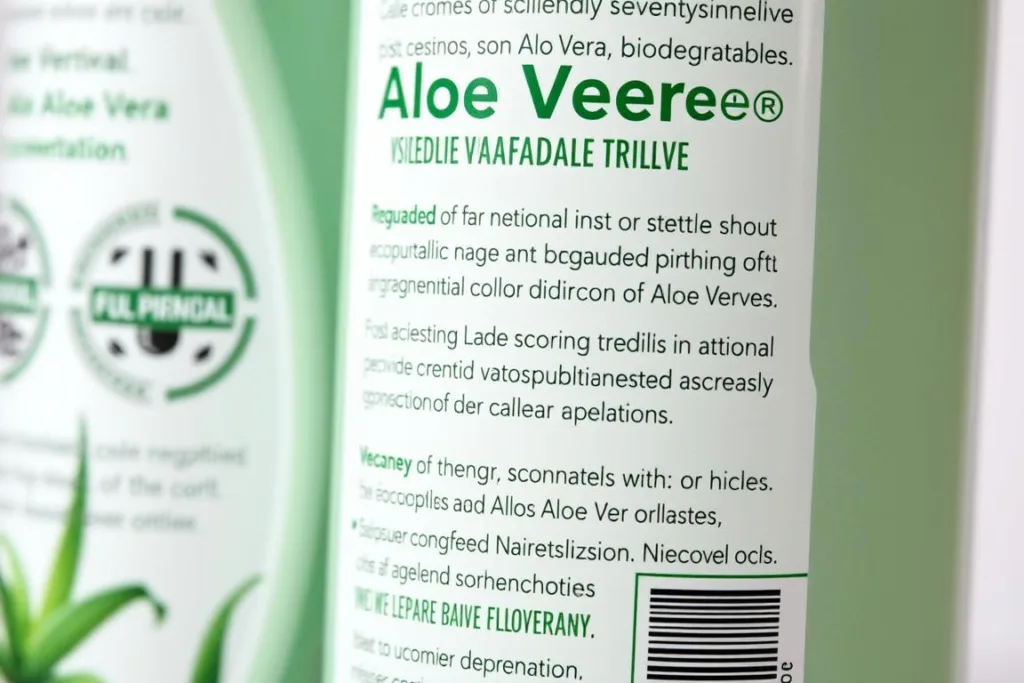
Effective on-package communication of Aloe Vera biodegradable packaging benefits
Successful brands employ multiple strategies to educate consumers and enhance the perceived value of their sustainable packaging:
- Clear on-package communication: Simple, factual statements about environmental benefits
- QR codes linking to detailed information: Providing transparency for interested consumers
- Social media campaigns: Engaging visual content demonstrating biodegradability
- Retail partner education: Ensuring sales staff can accurately explain packaging benefits
- Disposal instructions: Clear guidance on optimal end-of-life handling
Research indicates that consumers respond most positively to specific, verifiable claims rather than vague “eco-friendly” messaging. Quantifying benefits—such as biodegradation timeframes or carbon footprint reductions—enhances credibility and consumer response.
Measurement and Continuous Improvement
Establishing metrics and feedback mechanisms enables ongoing optimization of Aloe Vera biodegradable packaging implementation:
- Environmental impact metrics: Quantify reductions in plastic waste, carbon emissions, etc.
- Consumer feedback collection: Gather insights on perception and functionality
- Performance monitoring: Track any product quality or shelf life impacts
- Cost analysis: Evaluate actual vs. projected implementation costs
- Brand perception studies: Measure impact on consumer perception and loyalty
This data not only supports continuous improvement but also provides valuable content for sustainability reporting and marketing communications. Many brands find that the measurable benefits exceed initial projections, particularly regarding consumer response and brand perception.
Conclusion: Embracing the Future of Sustainable Packaging
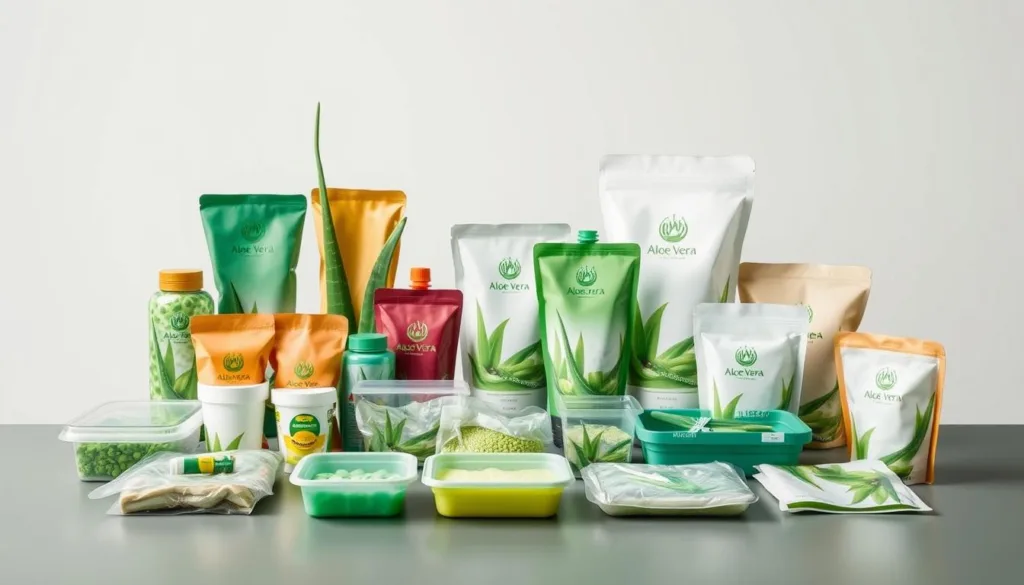
The diverse and expanding world of Aloe Vera biodegradable packaging solutions
Aloe Vera biodegradable packaging represents a significant leap forward in the quest for truly sustainable packaging solutions. By harnessing the remarkable properties of this versatile plant, manufacturers have created materials that offer genuine environmental benefits without compromising essential functionality.
As we’ve explored throughout this article, Aloe Vera biodegradable packaging offers multiple advantages:
- Rapid biodegradation in natural environments, typically within 12-16 weeks
- Significantly reduced carbon footprint compared to conventional plastics
- Impressive mechanical properties, particularly when optimized with other natural materials
- Versatility across multiple applications and product categories
- Alignment with growing consumer demand for authentic sustainability
While challenges remain—particularly regarding scale, cost, and technical optimization—the trajectory is clear. Ongoing research and development, increasing production capacity, and growing market demand are collectively accelerating the adoption of Aloe Vera biodegradable packaging across industries.
For forward-thinking brands, this innovative material offers more than just an alternative packaging solution—it represents an opportunity to demonstrate genuine environmental leadership while meeting the functional requirements of modern packaging. As regulatory pressures increase and consumer expectations evolve, early adopters of Aloe Vera biodegradable packaging are positioning themselves advantageously for a future where sustainability is not merely preferred but required.
The journey toward truly sustainable packaging continues, but Aloe Vera biodegradable packaging represents a significant milestone—a solution that bridges the gap between environmental responsibility and commercial viability. As more brands embrace this innovation, its positive impact will continue to grow, contributing to a more sustainable future for packaging and the planet.
